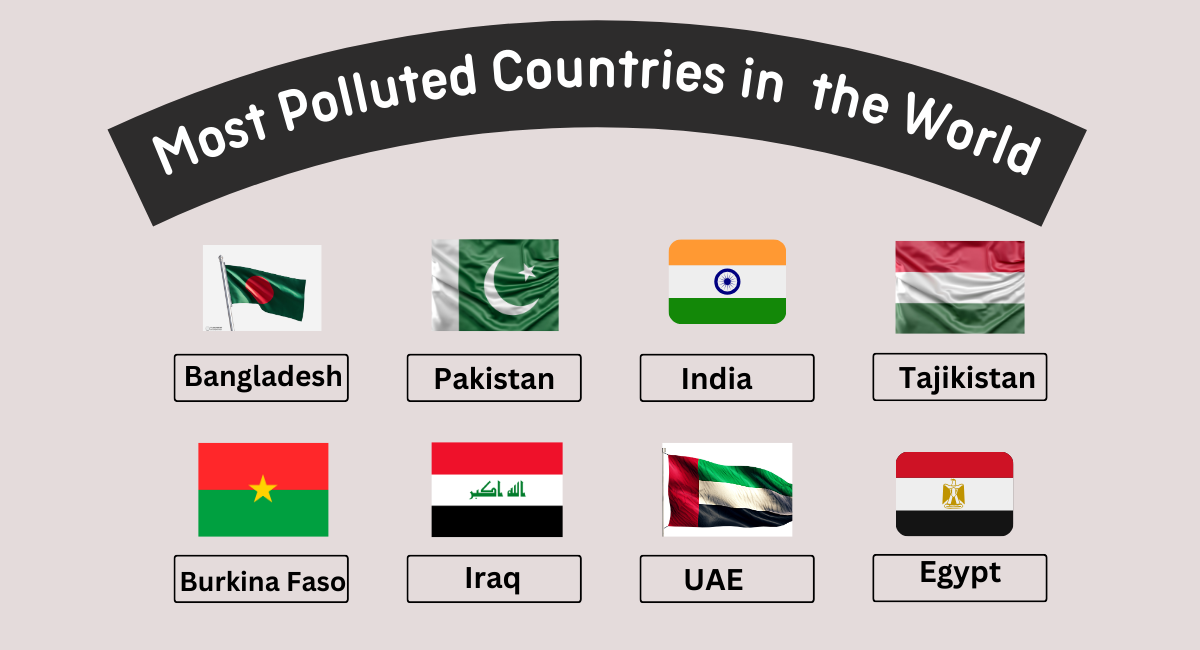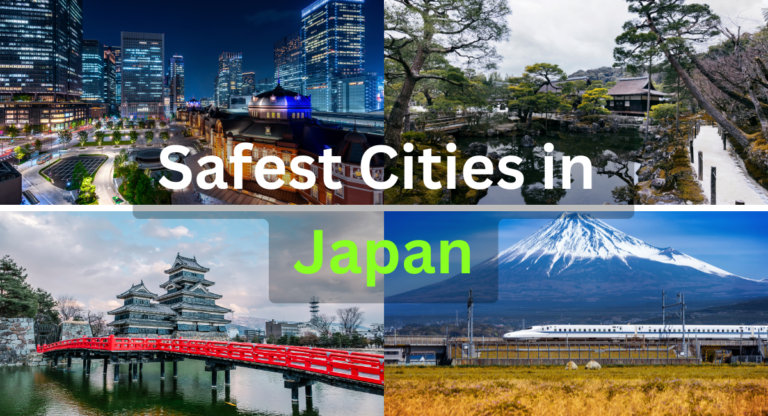8 of the Most Polluted Countries in the World
Pollution has emerged as one of the most pressing global crises, impacting the health and well-being of millions while wreaking havoc on our environment. In certain countries, this issue has reached catastrophic proportions, with pollution levels soaring to hazardous extremes that threaten public health. This article delves into the top 8 most polluted countries in the world, including Bangladesh, Pakistan, India, Tajikistan, Burkina Faso, Iraq, United Arab Emirates, and Egypt. Offering an in-depth look at the primary sources of their pollution, we will shed light on its dire consequences on human lives, and the various initiatives these nations are undertaking to combat this environmental disaster.
By understanding the severity and breadth of the pollution problem in these countries, we can gain a clearer perspective on the urgent need for global cooperation and innovative solutions. Stay with us as we explore the harsh realities faced by these countries and the steps they are taking to forge a cleaner, healthier future for their citizens and the planet.
So, let’s begin.
A List of 2024’s Most Polluted Countries Globally
- Bangladesh
- Pakistan
- India
- Tajikistan
- Burkina Faso
- Iraq
- United Arab Emirates
- Egypt
1. Bangladesh
Bangladesh stands as the most polluted country in the world, grappling with severe environmental challenges due to its alarming pollution levels. This pollution, which is mostly caused by human activities, poses a significant threat to its residents’ health and well-being. Household emissions from cooking with solid fuels, industrial effluents, and agricultural runoff are the key contributors. In rural areas, the prevalent use of solid fuels for cooking results in significant indoor air pollution, affecting both those who cook and the overall air quality.
Industrial activities exacerbate the situation by discharging untreated effluents into waterways, while agricultural practices involving pesticides and fertilizers contribute to soil, water, and air pollution. The health impacts are severe and widespread. A World Bank analysis states that air pollution, dirty water, inadequate sanitation, and lead exposure cause around 272,000 premature deaths and 5.2 billion days of sickness per year. Household and outdoor air pollution alone account for nearly 55% of premature deaths. Alarmingly, children exposed to lead poisoning suffer a significant annual loss of around 20 million IQ points.
The environmental repercussions are equally dire. The pollution of waterways from industrial discharge and unmanaged waste, including plastics and untreated sewage, impacts not only public health but also biodiversity and ecosystems. Soil and air pollution jeopardize agricultural output and economic growth. In response, the Bangladeshi government has implemented measures through the Department of Environment to reduce air pollution, promote cleaner fuels, and enforce stricter emission standards. Programs to improve waste management and increase renewable energy usage are also underway, alongside the draft Clean Air Act of 2019, which aims to provide a comprehensive framework for addressing air pollution.
Despite these efforts, Bangladesh faces significant challenges due to ineffective enforcement mechanisms, inadequate infrastructure, rapid economic growth, and population pressures. Addressing the pollution crisis remains a critical priority for the nation’s future.
Also Read: Happiest States in the US
2. Pakistan
Pakistan, located in South Asia, is the world’s second-most polluted country. The nation’s rapid industrialization, urbanization, and population growth have led to escalating pollution levels. The pollution issue in Pakistan is multifaceted, with the industrial sector being a major contributor. Industries such as cement, steel, and textiles emit various pollutants, including particulate matter, sulfur dioxide, nitrogen oxides, and volatile organic compounds, severely impacting air quality.
Additionally, the burgeoning number of vehicles on Pakistan’s roads, many of which are outdated and poorly maintained, significantly contributes to air pollution. Emissions from vehicles are a major source of nitrogen oxides, carbon monoxide, and hydrocarbons. Agricultural practices, like the burning of crop residues and biomass and the use of low-quality fuels for cooking and heating, further exacerbate air pollution.
The health impacts in Pakistan are dire, with poor air quality linked to respiratory issues, cardiovascular diseases, and cancer. As of 2024, air pollution is responsible for around 128,000 deaths each year. Water pollution also presents severe health risks, with contaminated water supplies causing waterborne diseases such as cholera and typhoid. The dual threat of air and water pollution not only endangers public health but also degrades the environment and diminishes the country’s natural beauty.
The Pakistani government has launched several initiatives to combat pollution. The National Clean Air Policy (2023) encourages clean cooking fuels and technologies, particularly in rural and semi-urban areas. The Ministry of the Environment is developing the National Clean Air Plan, which sets pollution concentration targets and action plans for air quality management. Pakistan is also a signatory to the Global Methane Pledge, committing to reduce methane emissions by at least 30% by 2030.
Despite these efforts, Pakistan still confronts tremendous hurdles in combating pollution. Ineffective enforcement of pollution regulations, limited financial and human resources, and rapid population growth hinder the government’s ability to tackle this critical issue effectively.
3. India
India, renowned for its rich cultural heritage and rapid economic growth, also faces a severe air pollution crisis. In 2024, India ranks among the countries with the worst air quality, with millions of people dying annually due to a polluted environment.
The sources of pollution in India vary and are widespread. Major contributors include vehicular emissions, industrial waste, smoke from cooking, construction activities, crop burning, and power generation. India’s heavy reliance on gas, oil, and coal for electricity makes it the fifth-largest polluter globally, emitting over 2.65 billion metric tons of carbon dioxide annually.
The health consequences of air pollution in India are frightening. Chronic exposure to polluted air is linked to long-term health issues such as heart and lung disease, resulting in approximately 7 million premature deaths each year. Additionally, India’s air pollution crisis significantly contributes to global warming. The Intergovernmental Panel on Climate Change (IPCC) has warned that the climate catastrophe is worsening at an unprecedented pace.
Despite the severity, the Indian government has initiated measures to combat the issue. A nationwide ban on single-use plastics aims to reduce plastic waste. In Delhi, the State Government has implemented the Odd-Even Regulation to reduce traffic emissions and banned coal use in industrial and domestic units in the National Capital Region (NCR). However, the scale of the problem often overwhelms these efforts.
A recent study from Stanford University highlighted that about 30 power plants in India are responsible for a quarter of the pollution-related mortality burden. Targeting these plants with pollution control technologies could save thousands of lives. Despite these findings, India’s plan to increase coal-generated electricity by 50% between 2018 and 2030 poses a significant challenge. This expansion could lead to an estimated 844,000 premature deaths if not mitigated. India’s pollution crisis requires urgent, comprehensive action to protect public health and the environment.
4. Tajikistan
Tajikistan, nestled in the heart of Central Asia with its stunning mountains and vast deserts, attracts numerous visitors each year. However, its environmental safety situation is alarming. Recent surveys indicate that pollution accounts for 19.6% of deaths in the country.
A primary source of pollution in Tajikistan is the poor management of chemicals and waste. The country generates substantial waste, nearly a kilogram per person daily, amounting to over 2 million tonnes annually. This mismanagement leads to significant environmental and health issues.
The industrial sector also contributes heavily to pollution, particularly in major cities like Dushanbe. Dependence on coal and cement production has escalated air pollution levels. According to the World Health Organization, air pollution in Tajikistan significantly contributes to the 7 million premature deaths caused globally by poor air quality. The country’s deteriorating air quality has led to a spike in respiratory issues, heart disease, and premature mortality.
Furthermore, ineffective waste management has contaminated water sources, posing a severe public health risk. Despite these challenges, Tajikistan has made efforts to address pollution. The country has ratified the Basel and Stockholm conventions, aiming to reduce hazardous waste generation and transboundary movement.
The Tajik government has also partnered with international organizations, such as the United Nations Environment Programme (UNEP), to enhance chemicals and waste management practices. These collaborative efforts reflect Tajikistan’s commitment to improving its environmental safety and public health, although significant challenges remain.
5. Burkina Faso
Air pollution is a significant concern in Burkina Faso, with the country’s air quality considered unsafe due to annual mean concentrations of PM2.5 exceeding recommended levels. Various socio-economic activities, including agriculture, energy, and industry, are the main contributors to this air pollution. Another contributing factor is the high rate of infectious and contagious diseases, with malaria being the leading cause of illness and death, resulting in approximately 19,979 deaths in 2020. It is also the primary cause of death for children under five.
Water pollution presents another critical challenge. The extensive use of chemical fertilizers and pesticides in agriculture has led to significant water contamination, particularly in the cotton basin in the southwestern part of the country. This pollution affects both the environment and public health, making clean water access a persistent issue.
Recognizing the urgency of these environmental issues, the government of Burkina Faso has undertaken several initiatives to mitigate pollution. The National Development Strategy (NDS) places a strong emphasis on environmental protection and sustainable development. It aims to reduce greenhouse gas emissions by 16.25% by 2025 and 29.42% by 2030.
Additionally, the government has implemented various projects to improve waste management and reduce pollution. One notable initiative by the Ministry of Environment, Water, and Forests promotes the use of gas and improved cooking stoves, reducing indoor pollutant exposure. This project also aims to increase access to clean energy and decrease reliance on biomass for cooking. Through these efforts, Burkina Faso is striving to address its pollution challenges and protect public health and the environment.
Also Read: Most Polluted Cities in the UK
6. Iraq
Iraq’s pollution levels have seen a sharp increase, with PM2.5 concentrations rising from 39.6 in 2019 to an alarming 80.1 in 2022. This significant rise highlights the country’s escalating environmental challenges, primarily driven by industrial growth, traffic congestion, and recurrent dust storms. The ongoing conflict exacerbates the situation, causing infrastructure damage and increasing dust levels. Urban centers, particularly Baghdad, are severely affected, with residents suffering from high pollution levels due to traffic and industrial activities.
The oil sector’s gas flaring practices significantly contribute to air pollution in Iraq. Gas flaring, the burning of natural gas associated with oil extraction, releases large quantities of harmful pollutants, including carbon dioxide and methane, into the atmosphere. This practice not only deteriorates air quality but also contributes to global warming.
Water pollution is another critical issue in Iraq. The Tigris and Euphrates rivers, essential for the country’s water supply, are heavily contaminated with industrial waste, sewage, and agricultural runoff. This pollution has severe health implications, leading to the spread of waterborne diseases and posing a significant threat to public health.
In response to these challenges, the Iraqi government has undertaken several initiatives to combat pollution. Efforts include implementing stricter environmental regulations, promoting cleaner industrial practices, and improving waste management systems. Additionally, Iraq has partnered with international organizations to develop and implement environmental protection programs.
Despite these efforts, Iraq’s pollution crisis remains a pressing issue, necessitating further action to protect public health and the environment. Addressing the root causes of pollution and investing in sustainable practices are crucial steps toward mitigating the adverse effects of pollution in Iraq.
7. United Arab Emirates
The United Arab Emirates (UAE) faces significant environmental challenges, primarily due to rapid industrialization, urbanization, and a hot, arid climate. The country’s air pollution levels are high, with PM2.5 concentrations exceeding safe limits, primarily due to emissions from vehicles, industries, and construction activities. The energy-intensive lifestyle, reliance on fossil fuels, and frequent dust storms further exacerbate air quality issues.
Water pollution is another critical concern. The UAE’s limited freshwater resources are under pressure from industrial discharge, agricultural runoff, and desalination processes, which introduce pollutants into the environment. The reliance on desalination plants for potable water also raises concerns about marine pollution due to brine discharge.
Despite these challenges, the UAE government is proactive in addressing environmental issues. Initiatives such as the UAE Vision 2021 aim to achieve sustainable development while preserving the environment. The government has implemented policies to reduce emissions, promote renewable energy, and improve waste management. Projects like Masdar City, a planned eco-city in Abu Dhabi, exemplify the UAE’s commitment to sustainability and innovation in environmental management.
The UAE is also investing in green technologies and renewable energy sources, such as solar power, to reduce its carbon footprint. While significant progress has been made, ongoing efforts are crucial to mitigate the environmental impact of rapid development and ensure a sustainable future for the country.
8. Egypt
Egypt faces severe environmental challenges, primarily driven by rapid urbanization, industrial growth, and agricultural practices. Air pollution is a significant concern, especially in major cities like Cairo, where vehicle emissions, industrial activities, and open burning of waste contribute to high levels of PM2.5 and other pollutants. The dense urban population exacerbates the issue, leading to respiratory and cardiovascular health problems among residents.
Water pollution is another critical issue in Egypt. The Nile River, which is the country’s primary water source, is heavily contaminated by industrial discharge, agricultural runoff, and untreated sewage. This pollution not only threatens the health of millions who rely on the Nile for drinking water but also impacts agriculture and biodiversity.
The Egyptian government has launched several initiatives to address these environmental challenges. The National Environmental Action Plan aims to improve air quality, manage waste effectively, and reduce water pollution. Efforts include transitioning to cleaner fuels, promoting public transportation, and enhancing wastewater treatment facilities.
Furthermore, Egypt is investing in renewable energy, with significant projects in solar and wind power. The government’s commitment to the Paris Agreement underscores its dedication to reducing greenhouse gas emissions and mitigating climate change impacts.
Despite these efforts, Egypt’s environmental challenges remain daunting. Continued investment in sustainable practices, stricter enforcement of environmental regulations, and public awareness campaigns are essential to ensure a healthier environment and sustainable development for future generations.
Also Read: Forests in the United States
Summing Up
In conclusion, pollution is a critical global issue, affecting numerous countries with varying intensity. From the hazardous air quality in Bangladesh and Pakistan to the environmental challenges in India, Tajikistan, Burkina Faso, Iraq, the UAE, and Egypt, the impacts on public health and ecosystems are severe.
As the most polluted countries in the world, they face unique pollution sources and struggles, ranging from industrial emissions and vehicular pollution to waste management and agricultural runoff. Despite ongoing efforts and initiatives by governments and international organizations, significant challenges remain. Addressing pollution requires continued investment in sustainable practices, stricter regulations, and global cooperation to safeguard the environment and ensure a healthier future for all.
FAQs
Which Country Has the Highest Pollution Levels in 2024?
Bangladesh holds the title of the most polluted country in the world in 2024, grappling with severe environmental challenges due to extensive pollution.
What Is the Cleanest Country in the World?
Denmark is considered the cleanest country in the world, renowned for its high standards of cleanliness and quality of life.
Which Country Has the Purest Oxygen?
Iceland is known for having some of the cleanest air in the world. Its low population density, abundant greenery, and stunning natural landscapes contribute to its exceptional air quality. Located in Northern Europe, Iceland is a popular travel destination and a favored location for film shoots due to its scenic beauty and pure environment.
Which Is the Cleanest Country in Asia?
Singapore is renowned for having the cleanest streets and public areas in Asia and for maintaining high standards of cleanliness and public hygiene.

I’m Sophia Jones, an adventurer at heart from New York City, USA. I live for travel and exploration, always eager to discover new places, meet fascinating people, and try out diverse cuisines. Over the past few years, I’ve traveled to numerous countries, immersing myself in different cultures and creating unforgettable memories.






